#Dalhangari
Text

Why These Imperfect Korean ‘Moon Jars’ Sell for Millions
Old, round, imperfect and beautiful — that’s how fans of Korean art describe the moon jar, or “dalhangari.”
These unassuming, plain white pots have entranced everyone from rapper RM, of K-pop sensation BTS, to philosopher Alain de Botton.
The former director of London’s Victoria and Albert Museum, Beth McKillop, has called the moon jar an “icon of Korean identity.” And if price is any indicator of popularity, one recently sold for over $4.5 million at a Christie’s auction.
This month, a rare example from the late 17th or early 18th century will go on sale at Sotheby’s in New York, where it’s expected to fetch more than $3 million.
“A large moon jar has always been expensive, but I think the big uptick in prices and value is… because their appeal is now global,” said Angela McAteer, Sotheby’s international head of Chinese art for the Americas and Europe, over video call. “You’ve got an international cohort of bidders competing for them, so it’s gone beyond the traditional connoisseur collecting community of Korean art.”

Huge price tags also result from the jars’ rarity. Although made for over a century in the royal kilns of Korea’s last kingdom, the Joseon dynasty, few are thought to exist today. Estimates for the number of larger ones (those more than 40 centimeters, or 15.7 inches, tall and wide) that have survived over the years range from 12 to 30.
Having passed through auction houses and antique dealers across the world, several of these are now in the collections of institutions like the British Museum and Boston’s Museum of Fine Arts, as well as in the hands of private collectors.
‘Owning a piece of happiness’
The first moon jars were created in the royal kilns in Gwangju (a city just outside Seoul, not the larger southern city of the same name) from 1650 to 1750. They were made from pure white porcelain and kaolin clay, and, following the neo-Confucian fashions of their day, the pots reflected values such as propriety, humility, frugality and purity. They were likely used at court and in upper-class homes as containers for food and liquids, or as decorative vessels.
In the mid-20th century, moon jars began gaining international appreciation thanks to influential admirers such as Japanese folk crafts scholar Yanagi Soetsu and British potter Bernard Leach, who bought one from a Seoul antique store in 1935. Leach once said that having a moon jar was like “owning a piece of happiness,” and would later give his to fellow potter Lucie Rie for safekeeping during World War II. It stayed in her studio until her death and was later acquired by the British Museum.
Charlotte Horlyck, lecturer in Korean Art History at the University of London’s School of Oriental and African Studies, wrote in the Art Bulletin journal that after World War II the moon jar “caught the attention of an early generation of postcolonial Korean artists and scholars who sought to restore Korean art history and national identity,” as the pieces “resonated with the visual language of international modernism and minimalism of the mid-20th century while remaining a distinctly Korean work of art.”
The moon jar’s allure
When Sotheby’s announced its forthcoming sale, the auction house described its 44-centimeter (17.3-inch) moon jar as an object that inspired, astounded and soothed those who “stand in its presence.” It’s a funny thing to say about a pot, to speak as if it’s alive, but the jars’ visceral, emotional impact on people is something that comes up time and time again in the literature.

Choi Sunu, a former director of the National Museum of Korea, has described the museum’s moon jars as being like companions, or muses that have inspired his writing and stirred his creativity. Bernard Leach admired the pots for their “natural unselfconsciousness.” In 2012, South Korea’s then-Unification Minister Yu Woo-ik used the pot as a metaphor symbolizing a reunified Korean peninsula (moon jars are created in two hemispherical pieces and joined in the middle).
More recently the rapper RM, of K-pop group BTS, posted a picture of himself hugging a modern-day moon jar on Twitter, telling fans that the pots made him feel calm.
“It’s hard for someone to really comprehend how a pot can make you feel that way,” said McAteer. “It has this real meditative presence. If you’ve sat in front of a great (painting by US artist, Mark) Rothko and you feel this kind of palpable energy emanate from it, and you could sit for hours and just feel something in its presence — the moon jar has that too.”
“The more you look at it, the more there is to see. It looks different from every angle,” she added. “We had real issues with the photography and the catalog because it looks like a different piece every time you rotate it, or you change the lighting. The surface is just alive, you know.”
“You can see how the glaze coalesces; you see these spontaneous bursts of this blush color that’s happening in the firing. You can lose yourself in its surface.”
Modern masters
Modern Korean potters have been inspired by the jars, and a number have come up with their own homages. Ceramist Kim Syyong covers his pots with a black glaze, while Yun Ju Cheol’s versions look spikier like a pufferfish and Choi Bo Ram’s unvarnished, textured blue vases have a denim-like quality.
Others, like Kwon Dae Sup, have looked to closely recreate the process used by the potters of yore. The 71-year-old ceramist produces unadorned white jars and allows for all the beautiful imperfections produced to shine through. He works out of a studio in Gwangju, where the royal kilns that produced moon jars were once located.


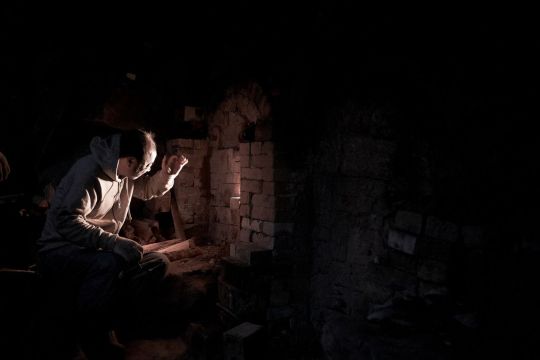
There’s a great deal of preparation that goes into making a moon jar traditionally. It’s labor-intensive: washing, sifting impurities from the clay, kneading and rolling it to remove air bubbles, carrying around these large hunks, not to mention hand throwing the clay itself to that oversized bowl shape without collapsing, and the work keeping a pine wood fire burning for 24 hours while the pot hardens in the kiln. Kwon also built his own kiln to replicate the old process as closely as possible.
“I do this because it’s fun,” he said in a phone interview. “Every time I make something, it’s novel … The quality of the material is different every time. The conditions in which I make the pots is new every time.”
Kwon said he also feels an emotional connection to the moon jar. As a student he was so moved by a one he saw in a Korean antique store that he decided they would be his life’s work. “They feel alive,” he said.
In a 2019 book on his work by Axel Vervoodt Gallery the potter is quoted saying he tries to produce art that needs no addition or subtraction. “I wish to create work that has an imposing presence but harmonizes with its surroundings regardless of where and when it is displayed. It should give peace of mind and a sense of comfort to all who look at it.”
By Christy Choi.
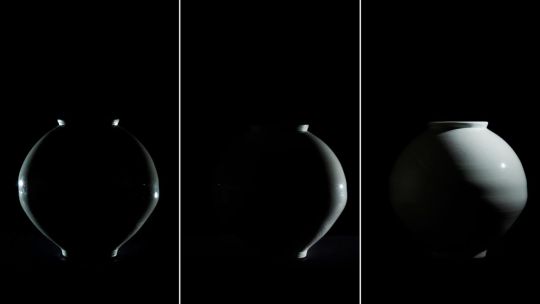
#Moon Jars#Why These Imperfect Korean ‘Moon Jars’ Sell for Millions#Dalhangari#Joseon dynasty#pottery#porcelain#Bernard Leach#Lucie Rie#Kwon Dae Sup#ancient artifacts#archeology#archeolgst#history#history news#ancient history#ancient culture#ancient civilizations#korean history#korean art#art#artist#art work#art world#art news#long reads
127 notes
·
View notes
Text
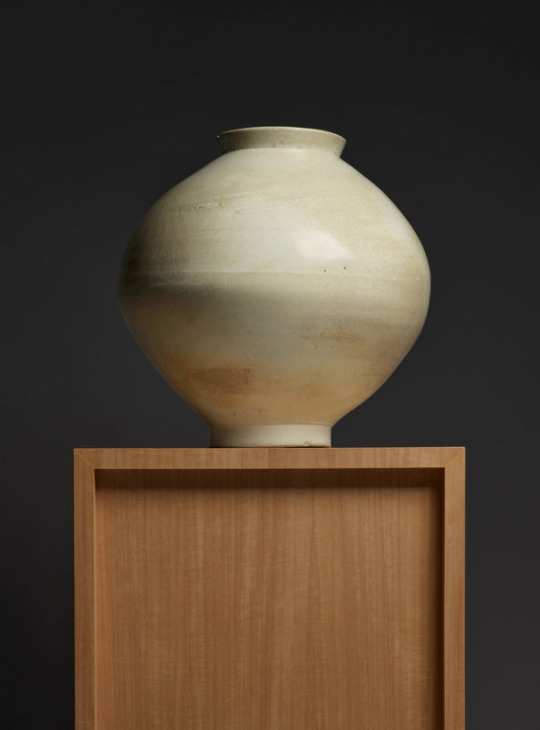
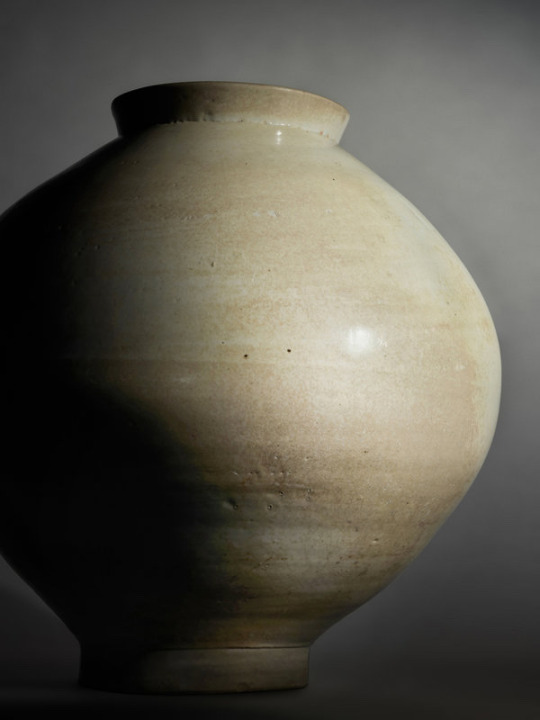

An important white-glazed moon jar, Joseon dynasty, late 17th-early 18th century.
“Like the moon of the 13th or 17th day”
A large white-glazed moon jar universally admired for its luminous white porcelain surface, elegant, gravity-defying proportions, and charming idiosyncrasies, the evocatively named moon jar (dalhangari) epitomizes the nuanced, natural beauty acclaimed in Korean ceramics. Completely unique to Korea, moon jars were produced for a short amount of time during the Joseon dynasty (1392-1910) in the 17th and 18th centuries, likely for storage of grain or liquid. The jar’s deceptively simple form, plain surface, and striking materiality led to its “rediscovery” in the 20th century by art historians and artists alike. Indeed, the term “moon jar” is a modern moniker attributed to the Korean artist Kim Whan-ki (1913-1974), coined around the 1940s when Kim and other artists wrote lyrically about the vessel. In the Joseon period, it was simply referred to as a “large white ceramic jar” or “round jar” (wonho 圓壺).[1] From its humble beginnings as a utilitarian vessel, the moon jar has transcended geographic and cultural boundaries to become one of the most iconic and influential works of art in modern times, equally significant in the history of Korean ceramics, the development of modern studio pottery, and global art history.
Joseon Porcelain in the 17th and 18th century
Porcelain was introduced to Korea during the Yuan (1279-1368) and early Ming (1368-1644) dynasties in China, exemplified by blue and white vessels decorated with dragons given by the Ming Xuande Emperor (r. 1425-1435) to the Joseon King Sejong (r. 1418-1450). Soon, porcelain was made domestically in official court-sponsored kilns at Bunwon, near the capital city of Hanyang (present-day Seoul). These kilns supplied porcelains to the royal court for use in daily life and state rituals. The production of these vessels was highly regulated, with government-appointed supervisors overseeing the selection of raw materials and ceramic production. From its inception, porcelain was regarded as a material for Joseon elites—sumptuary laws restricted the use of porcelain to the court, and those who violated this rule were punished.[2]
Courtesy Alain Truong
11 notes
·
View notes
Text
Emmaline O’Dowd reads ‘Dalhangari’ (Issue 92)
View On WordPress
0 notes
Photo

Dal Hang-Ari. Beautiful and elegant Korean Moon jar. ⠀ #moonjar #dalhangari #Korea #pottery (Seoul, Korea에서) https://www.instagram.com/p/CHaVn1AA5IE/?igshid=bvdvf2z92r1e
0 notes
Photo




Moon jar, second half of the 18th century, Korea, porcelain
A distinctive type of porcelain from the late Joseon period (1392–1910), the moon jar (Korean: dalhangari)—so called because of its evocative form—was usually made by joining two hemispherical halves. The peach hue of the glaze, unintentionally acquired during firing, adds to the charm of this jar.
4K notes
·
View notes
Text
Korean traditional pottery
Dragon jar
Second half of the 18th century
Porcelain jars painted with cobalt-blue dragons were popular from the seventeenth through the nineteenth century. Many were used as flower vases in official court ceremonies. Originally associated with water, dragons were also imperial emblems throughout East Asia. The two four-clawed dragons chasing flaming jewels on this piece embody the dynamic strength of the mythical beast. At the same time, their amusing, rather than savage, faces reflect the notion of dragons as auspicious, welcome creatures not to be feared.

More info at MetMuseum
Moon jar
Second half of the 18th century
A distinctive type of porcelain from the late Joseon period, the moon jar (Korean: dalhangari)—so called because of its evocative form—was usually made by joining two hemispherical halves. The peach hue of the glaze, unintentionally acquired during firing, adds to the charm of this jar.

More information at MetMuseum
Brush holder with lotus decoration
Mid-19th century
Scholarly men of the Joseon dynasty collected and used tasteful accessories, such as this piece and the water droppers, for writing or painting. The lotus is an emblem of the Confucian scholar aptly used here to ornament an object for his study.

More information at MetMuseum
Ring-shaped water dropper
19th century
To prepare ink for calligraphy or painting, a Joseon scholar might have used this instrument to drip water onto an inkstone for grinding an ink stick. Porcelain water droppers, often in whimsical shapes and with or without painted decoration, were fashionable during the nineteenth century.

More information at MetMuseum
Maebyeong with lotus decoration
late 11th–early 12th century
The effect of the delicately carved lotus design under the translucent celadon glaze is subtle. Literally meaning “plum bottle,” maebyeong is a shape inspired by contemporaneous and earlier Chinese vessels. Korean celadon maebyeong developed fuller forms: broad shoulders, as in this piece, or curvilinear contours.
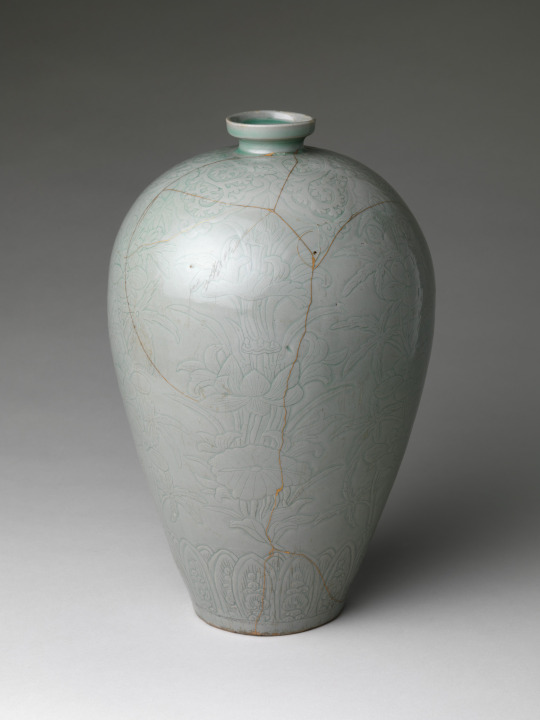
More information at MetMuseum
Maebyeong decorated with cranes and clouds
Second half of the 12th century
The cranes and clouds, popular motifs on Goryeo celadon, are delicately yet expressively rendered. Set against the green color of the glaze, they appear to be floating in the sky.

More information at MetMuseum
#art#pottery#korean pottery#history#study notes#studyspo#Study resources#studyblr#studyinspo#lifelong learning#LifeLongLearning#justalifelonglearner
9 notes
·
View notes
Photo

caught up with @dalhangari who was dressed beautifully ✨ at #LACMAKoreaNight featuring traditional and contemporary designs from @meehee.hanbok 🎎 🇰🇷 my 1st time seeing hanbok in person ! (at LACMA Los Angeles County Museum of Art)
6 notes
·
View notes
Text
RM’s Art Exhibition Trips Show Just How Much “CONNECT, BTS” Means To Him

It’s only been a few days since BTS unveiled their new global art project, CONNECT, BTS, but fans already know how much it means to the members. During a video conference, Jin explained how the project would connect people through diversity, while Jungkook said it would highlight the similarities between artwork and music.
The project must mean a lot to RM too—after all, he’s constantly spotted attending art exhibitions just like the ones CONNECT, BTS will be showcasing. Let’s take a look at 5 times RM proved how deep his love for art is.
1. The National Gallery, London
The CONNECT, BTS series just began with an exhibit at the Serpentine Galleries in London—fitting for RM, who has visited art galleries in London before.
When BTS headed to London for their sold-out “Love Yourself: Speak Yourself“ shows at Wembley Stadium, RM made sure to find the time to visit the city’s famous National Gallery.
Fans in London spotted RM looking at a famous 1700s painting by Canaletto titled Venice: The Grand Canal with S. Simeone Piccolo, which uses perspective, light and detail to depict the beautiful architecture of the city.
namjoon went to a gallery and jikook went on a lunch date

i love seeing them having fun and going out into the city i love them so much pic.twitter.com/nGp276qRDb
— myrcka⁷

(@bffjeongguk) June 3, 2019
2. Metropolitan Museum of Art, New York City
RM often squeezes art trips into BTS’s overseas schedules. When the group flew to New York City to perform at the MetLife Stadium last May, RM uploaded photos of himself at the Metropolitan Museum of Art (also known as the Met).
He even included a cute pun in his tweet!
I met MET

pic.twitter.com/t6zhunGrGi
— 방탄소년단 (@BTS_twt) May 17, 2019
In his photos, RM can be seen viewing various classic art pieces, including Lane in the Poppy Fields by Claude Monet.
Seems like the Met was just as glad to meet him. After his visit, they posted a tweet thanking him for his visit in Korean.
방문해 주셔서 감사합니다!
— The Met (@metmuseum) May 17, 2019
3. Normal Life by Kim Hee Soo, Seoul
Alongside centuries-old paintings, RM is a fan of contemporary art too. Last September, he shared pictures of his visit to the Normal Life solo exhibition in Seoul, featuring artwork by modern painter Kim Hee Soo.
The artist paints ordinary people with no expression or personality so the viewer can imagine themselves in the painting. It must be a unique and fulfilling experience for RM, whose life is anything but ordinary!
On Instagram, Kim revealed that RM even came to meet him during his visit.
View this post on Instagram
남준님 와주셔서 감사했습니다. 반가웠습니다! 사진_ BTS_twt트위터
A post shared by heenang Heesookim 희낭 김희수 (@heesookim_) on Sep 24, 2019 at 4:23am PDT
4. Bonte Museum, Jeju Island
What would an RM vacation be without an art trip? While on a break in Jeju, RM visited the Bonte Museum, which showcases traditional and modern Korean crafts.
One of the exhibitions he looked at was Infinity Mirrored Room – Gleaming Lights of the Souls by Yayoi Kusama.
This unusual installation, which has traveled the world, is a small 4×4 meter space with mirrored walls and ceilings. The viewer stands in a platform in the middle of the water pool floor while a hundred color-changing lights surround them.
5. Kwon Dae Sup, Gyeonggi
On one of his most recent art trips, Namjoon tweeted a photo of himself hugging a large “moon jar”—a traditional form of Korean pottery, also known as dalhangari.
These huge pots are even more impressive than they seem—each one uses at least 40kg of clay and is painstakingly made from two separate halves joined together. The artist, Kwon Dae Sup, originally intended to be a painter until he was struck by sudden inspiration when he came across an antique moon jar.

Kwon Dae Sup, moon jar artist
Perhaps RM couldn’t make it to the artist’s exhibition at the Park Ryu Sook Gallery earlier that month, as eagle-eyed fans noticed that their idol actually viewed the jars at Kwon’s own house near Paldang Lake, Gyeonggi.
#Namjooning 191117
달항아리 / Moon jar by Kwon Dae Sup
Namjoon went to Kwon Dae Sup's house along Paldang Lake, Gyeonggi.@BTS_twt #RM #알엠 #남준 #김남준 #BTS #Namjoon pic.twitter.com/FGCQ7JKaQV
—

#WinterFlower

MotS:7⃣ (@LemonamuRM) November 17, 2019
CONNECT, BTS will connect over 22 artists in five cities, including Seoul.
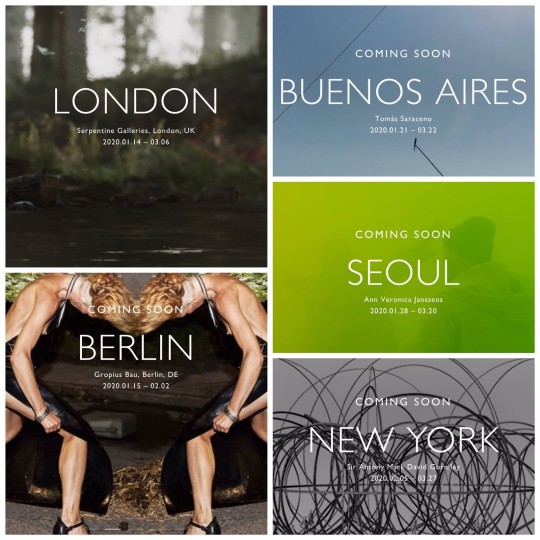
“CONNECT, BTS” schedule
Hopefully RM and the rest of the BTS members will get a chance to visit the Seoul exhibition when it launches later this month!
This content was originally published here.
0 notes